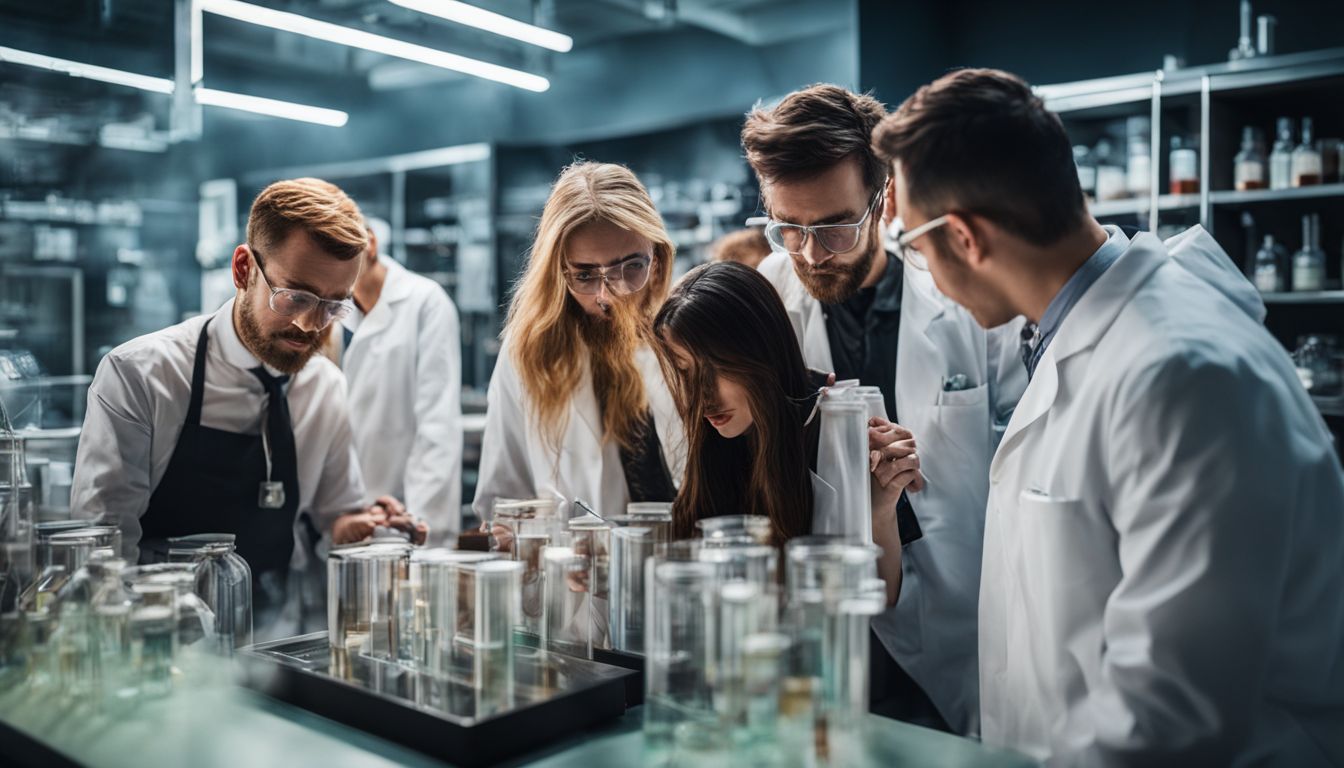The Science Behind Pheromones in Humans: Exploring Their Effects and Existence
Ever wonder why certain people just smell irresistible? It turns out, chemicals called pheromones might be the secret. Our blog post will dive into what these mystery scents are and whether they really influence human behavior.
Keep reading – it’s about to get fascinating!
Key Takeaways
- Pheromones are chemical signals secreted by the body that may influence human behavior, including attraction and reproductive patterns. Notably, androstadienone is a compound in male sweat thought to boost women’s sexual interest.
- The scientific community debates the existence of human pheromones due to conflicting research findings and challenges in definitively identifying these compounds.
- Despite uncertainty in scientific circles, companies have created products featuring pheromones with claims of enhancing attractiveness and social interaction; however, these products’ effectiveness remains under scrutiny.
- Research suggests that similar to animals, human pheromones could be subtly guiding social interactions like menstrual synchrony among women living together.
- Future studies on human pheromones aim to unravel their precise role within our bodies and society, potentially revealing innovative ways they can improve interpersonal connections.
What Are Pheromones?
Pheromones are chemical signals that play a role in olfactory communication and social behavior. They can be found in various sources within the human body, and research on their existence dates back to historical studies.
Definition
Pheromones are unique chemical signals that organisms release to communicate with others of their species. These powerful scent signals can have profound effects on social behavior, including attraction and reproductive patterns.
In the context of human biology, they may act as invisible messengers, potentially altering mood, sexual orientation, or even genetic compatibility among individuals. Underlying these interactions is the olfactory system which detects and processes these olfactory signals.
Despite ongoing research into human pheromone production and detection, scientists still debate their exact role in chemical communication. Some studies find that chemicals like androstadienone influence sexual desire in women when smelled.
However, identifying definitive pheromone receptors in humans remains a challenge for science. The exploration furthers our understanding of how biological signaling molecules shape human interaction and societal connections through neurological responses triggered by scented cues.
Sources in Humans
The human body produces pheromones through certain glands, including the apocrine glands found in areas like the armpits and genital region. These compounds are released into the environment, conveying information to others about an individual’s reproductive status, immune system quality, and genetic compatibility.
Androstadienone, a type of pheromone produced in human sweat, has been linked to boosting sexual desire and arousal in women when detected under certain conditions. Additionally, research suggests that female pheromones can influence male behavior and have significant implications for attraction.
Human pheromone sources are mainly linked to specialized sweat glands such as the apocrine glands situated in areas like the armpits and genital region. These unique compounds convey crucial information about an individual’s reproductive status, immune system quality, and genetic compatibility to others.
Historical Research
Historical research on human pheromones has been ongoing for many years, with early studies focusing on animal behavior and scent communication. Scientists have long studied the role of pheromones in social interaction and reproductive hormones, seeking to understand their influence on sexual attraction and other behaviors.
Early studies laid the groundwork for current research into human pheromones, leading to a better understanding of how chemical messengers play a role in evolutionary biology.
The quest for human pheromones has its roots in historical research on animal communication and reproduction, paving the way for modern investigations into the effects and existence of these chemical signals in humans.
This historical perspective gives insight into the development of current scientific inquiries surrounding scent communication and its impact on social interaction.
The Quest for Human Pheromones
Researchers have been on a quest to identify and understand human pheromones, with studies focusing on sources of putative human pheromones, sensory studies of axillary secretions, and the potential role of specific compounds like androstenone, androstenol, and androstadienone.
This research aims to shed light on the existence and effects of pheromones in humans.
Sources of Putative Human Pheromones
Human sources of putative human pheromones include body secretions such as sweat and urine. These bodily fluids contain compounds that are thought to act as chemical communication signals between individuals.
Androstadienone, a compound found in male sweat, is one of the substances believed to have pheromonal properties. Additionally, research suggests that certain compounds found in female urine may also function as putative human pheromones, influencing male behavior.
Studies on axillary secretions have shown that they contain odorous molecules capable of activating brain regions associated with social and olfactory processing. Furthermore, the scent of these secretions has been linked to potential effects on mood and behavior in recipients.
Sensory Studies of Axillary Secretions
Studies have shown that human axillary secretions contain compounds that may act as pheromones. These chemical signals, including androstenone and androstenol, are believed to play a role in human attraction.
Research suggests that these compounds can elicit specific responses from others through the olfactory system.
Scientists have conducted studies examining how individuals respond to different types of axillary secretions. These investigations aim to understand the effects of these chemical signals on human behavior.
Androstenone, Androstenol, and Androstadienone as Pheromones
Androstenone, androstenol, and androstadienone are types of pheromones found in humans. Androstenone is known for its musky scent and has been linked to sexual attraction. Human studies have shown that exposure to this pheromone can influence mood, making individuals more attentive.
Androstenol, commonly associated with a more pleasant smell, is believed to play a role in social interactions by enhancing approachability and friendliness. Lastly, androstadienone has been found to affect women’s arousal levels when exposed to it under specific contexts.
Research suggests that these compounds may impact human behavior through the olfactory system. The role of these pheromones extends beyond simple attraction as they also seem to modulate social dynamics and emotional response.
Menstrual Synchrony Pheromones
While the debate over human pheromones continues, some researchers have investigated the potential existence of menstrual synchrony pheromones. Studies suggest that women may release chemical signals affecting hormonal synchronization in other women, potentially aligning menstrual cycles when living in close proximity.
This phenomenon has been a subject of interest as it raises questions about how human social behaviors may be influenced by subconscious chemical communication.
Some studies have indicated that exposure to certain odors or chemicals can lead to alterations in hormone levels and menstrual patterns among women. While the exact nature and mechanism of these potential pheromones remain under investigation, this area of research contributes to our understanding of how human bodies interact on a chemical level and sheds light on subtle influences within social dynamics.
The Debate on Human Pheromones
Conflicting evidence and the lack of definitive identification have sparked ongoing debate about the existence and effects of human pheromones.
Conflicting Evidence
Conflicting evidence regarding human pheromones has fueled the ongoing debate about their existence. Studies on the effects of putative human pheromones have yielded mixed results, contributing to the lack of consensus among researchers.
For example, while some studies suggest that androstadienone can influence sexual desire in women, other research contradicts these findings. Additionally, conflicting evidence arises from attempts to definitively identify and isolate specific compounds as human pheromones.
The discordant results from different studies make it challenging to reach a definitive conclusion about the existence and effects of human pheromones.
On one hand, sensory studies indicate that humans produce airborne compounds that could potentially serve as pheromones; on the other hand, this evidence is met with skepticism due to methodological limitations and inconsistent findings across various experiments.
Lack of Definitive Identification
Scientists have not definitively identified human pheromones, making the existence of these compounds a matter of ongoing debate. While some research points to the potential impact of pheromones on attraction and behavior, there is no consensus on specific chemical compounds that can be classified as human pheromones.
The lack of a clear definition and conclusive evidence presents challenges in recognizing and understanding the role of pheromones in human interactions.
Some researchers argue that conflicting evidence regarding the identification of human pheromones has led to uncertainty about their effects and significance. Despite efforts to isolate specific compounds, the elusive nature of human pheromones continues to pose challenges for definitive identification.
Do Human Pheromones Have an Effect?
Studies have shown that human pheromones may have an effect on attraction and social behavior, similar to their role in other mammals. This has led to the development of various pheromone products aimed at enhancing attractiveness and social interactions.
Studies on Attraction
Studies have shown that human pheromones can play a role in attraction and sexual behavior. For example, research on androstadienone, a type of male pheromone, has indicated its potential influence on women’s arousal and sexual desire.
Furthermore, investigations into female pheromones have suggested their ability to affect male behavior. These studies provide evidence supporting the idea that human pheromones can impact interpersonal attraction and sexual behaviors.
Additionally, the development of pheromone-based products indicates an interest in utilizing these compounds for enhancing attractiveness or altering social interactions. Ongoing exploration of the specific scents associated with human pheromones continues to contribute to our understanding of their effects on attraction and behavior.
Role in Other Mammals
Pheromones play a significant role in other mammals, influencing various social and reproductive behaviors. For example, in mice, pheromones are crucial for mating rituals and the establishment of social hierarchies within their communities.
These chemical signals also contribute to parental care behaviors, enabling bonding between offspring and their caregivers.
In addition to this, pheromones have been observed to impact territorial marking and scent communication among many mammalian species. In certain cases, they can even influence stress levels and trigger defensive or aggressive responses when detected by other members of the same species.
Pheromone Products
While research into the effects and existence of pheromones in humans is ongoing, there is growing interest in harnessing their potential through pheromone products. Companies are exploring the use of human pheromones in perfumes and other consumer goods.
The idea behind these products is to enhance attractiveness, confidence, and social interactions by leveraging the potential influence of synthesized or extracted pheromones on human behavior.
While the scientific consensus on the efficacy of such products may still be debated, their development serves as a testament to the increasing fascination with the possible impact of human pheromones on interpersonal dynamics.
The potential market for these products highlights an emerging trend where consumers seek to explore ways to tap into natural biological cues for enhancing personal allure and appeal.
Conclusion
In conclusion, human pheromones continue to intrigue scientists and researchers. Studies have revealed their potential impact on attraction, sexual behavior, and endocrine function.
The ongoing exploration of human pheromones holds promise for unlocking the mysteries behind their effects and existence. Further research will contribute to a deeper understanding of how these chemical signals influence human behavior.
FAQs
1. What are pheromones in humans?
Pheromones in humans are chemicals that the human body produces, which can influence other people’s behavior or emotions when they detect them through their sense of smell.
2. How do scientists study pheromones and their effects?
Scientists use pheromone research to explore how these natural scents affect human interactions and relationships by conducting various experiments and studies.
3. Can we actually smell pheromones in other people?
Yes, even though it’s not like smelling food or flowers, our bodies have a special way to pick up on the subtle signals from pheromonessometimes without us even knowing!
4. Do all humans give off the same pheromones?
No, every person has their own unique scent! Our individual body odor includes different combinations of chemicals that can act as personal signatures.









